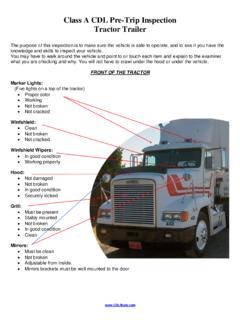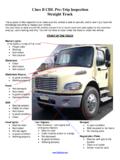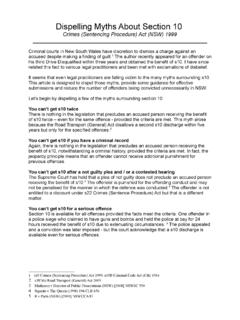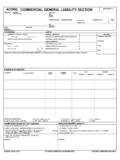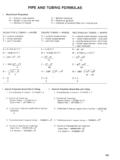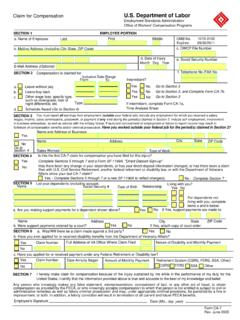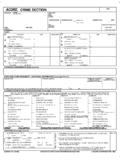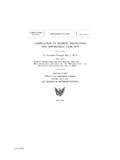Transcription of Section 9: Hazardous Materials - CDL Test …
1 Hazardous Page 9-1 Section 9: Hazardous Materials Hazardous Materials are products that pose a risk to health, safety, and property during transportation. The term often is shortened to HAZMAT, which you may see on road signs, or to HM in government regulations. Hazardous Materials include explosives, various types of gas, solids, flammable and combustible liquid, and other Materials . Because of the risks involved and the potential consequences these risks impose, the handling of Hazardous Materials is very heavily regulated by all levels of government. The Hazardous Materials Regulations (HMR) are found in parts 171-180 of title 49 of the Code of Federal Regulations. The common reference for these regulations is 49 CFR 171-180. The Hazardous Materials Table in these regulations contains a list of these items.
2 However, this list is not all-inclusive. Whether or not a material is considered Hazardous is based on its characteristics and the shipper's decision on whether or not the material meets a definition of a Hazardous material in the regulations. The regulations require vehicles transporting certain types or quantities of Hazardous Materials to display diamond-shaped, square-on-point, warning signs called placards. This Section is designed to assist you in understanding your role and responsibilities in hauling Hazardous Materials . Due to the constantly changing nature of government regulations, it is impossible to guarantee absolute accuracy of the Materials in this Section . An up-to-date copy of the complete regulations is essential for you to have. Included in these regulations is a complete glossary of terms. You must have a commercial driver license (CDL) with a Hazardous Materials endorsement before driving vehicles carrying Hazardous Materials which require placards.
3 You must pass a written test about the regulations and requirements to get this endorsement. Everything you need to know to pass the written test is in this Section . However, this is only a beginning. Most drivers need to know much more on the job. You can learn more by reading and understanding the federal and state rules applicable to Hazardous Materials as well as attending Hazardous Materials training courses. These courses are usually offered by your employer, colleges and universities, and various associations. You can get copies of the Federal Regulations (49 CFR) through your local Government Printing Office bookstore and various industry publishers. Union or company offices often have copies of the rules for driver use. Find out where you can get your own copy to use on the job. This Section Covers =The Intent of the Regulations =Driver Responsibilities =Communications Rules =Loading and Unloading =Bulk Tank Loading, Unloading, and Marking =Driving and Parking Rules =Emergencies Page 9-2 Commercial Driver's The regulations require training and testing for all drivers involved in transporting Hazardous Materials .
4 Your employer or a designated representative is required to provide this training and testing. Hazardous Materials employers are required to keep a record of that training on each employee as long as that employee is working with Hazardous Materials , and for 90 days thereafter. The regulations require that Hazardous Materials employees be trained and tested at least once every two years. The regulations also require that drivers have special training before driving a vehicle transporting certain flammable gas Materials or highway route controlled quantities of radioactive Materials . In addition, drivers transporting cargo tanks and portable tanks must receive specialized training. Each driver's employer or their designated representative must provide such training. Some locations require permits to transport certain explosives or bulk Hazardous wastes.
5 States and counties also may require drivers to follow special Hazardous Materials routes. The federal government may require permits or exemptions for special Hazardous Materials cargo such as rocket fuel. Find out about permits, exemptions, and special routes for places you drive. The Intent of the Regulations =Contain the material =Communicate the Risk =Assure Safe Drivers and Equipment Transporting Hazardous Materials can be risky. The regulations are intended to protect you, those around you, and the environment. They tell shippers how to package the Materials safely and drivers how to load, transport, and unload the material . These are called "containment rules." To communicate the risk, shippers must warn drivers and others about the material 's hazards. The regulations require shippers to put hazard warning labels on packages, provide proper shipping papers, emergency response information, and placards.
6 These steps communicate the hazard to the shipper, the carrier, and the driver. In order to get a Hazardous Materials endorsement on a CDL, you must pass a written test about transporting Hazardous Materials . To pass the test, you must know how to: =Identify what are Hazardous Materials . =Sfely load shipments. =Properly placard your vehicle in accordance with the rules. =Safely transport shipments. Learn the rules and follow them. Following the rules reduces the risk of injury from Hazardous Materials . Taking shortcuts by breaking rules is unsafe. Rule breakers can be fined and put in jail. Inspect your vehicle before and during each trip. Law enforcement officers may stop and inspect your vehicle. When stopped, they may check your shipping papers, vehicle placards, the Hazardous Materials endorsement on your driver license, and your knowledge of Hazardous Materials .
7 Hazardous Page 9-3 The Shipper: =Sends products from one place to another by truck, rail, vessel, or airplane. =Uses the Hazardous Materials regulations to determine the product's: - Proper shipping name. - Hazard class. - Identification number. - Correct packaging. - Correct label and markings. - Correct placards. =Must package, mark, and label the Materials ; prepare shipping papers; provide emergency response information; and supply placards. =Certify on the shipping paper that the shipment has been prepared according to the rules (unless you are pulling cargo tanks supplied by you or your employer). The Carrier: =Takes the shipment from the shipper to its destination. =Prior to transportation, checks that the shipper correctly described, marked, labeled, and otherwise prepared the shipment for transportation.
8 =Refuses improper shipments. =Reports accidents and incidents involving Hazardous Materials to the proper government agency. The Driver: =Makes sure the shipper has identified, marked, and labeled the Hazardous Materials properly. =Refuses leaking packages and shipments. =Placards his vehicle when loading, if required. =Safely transports the shipment without delay. =Follows all special rules about transporting Hazardous Materials . =Keeps Hazardous Materials shipping papers and emergency response information in the proper place. Hazardous Materials Transportation--Who Does What =The Shipper =The Carrier =The Driver Page 9-4 Commercial Driver's Figure 9-1 Hazardous Materials Hazard Class/Division Table Communication Rules =DefinitionsSome words and phrases have special meanings when talking about Hazardous Materials .
9 Some of these may differ from meanings you are used to. The words and phrases in this Section may be on your test. The meanings of other important words are in the glossary at the end of Section 9. A material 's hazard class reflects the risks associated with it. There are nine different hazard classes. Figure 9-1 tells the exact meaning of each hazard class. The types of Materials included in these nine classes are in the table below. Class Division Name of Class or Division Example 1 Mass Explosives Projection Hazards Mass Fire Hazards Minor Hazards Very Insensitive Extremely Insensitive Dynamite Flares Display Fireworks Ammunition Blasting Agents Explosive Devices 2 Flammable Gases Non-Flammable Gases Poisonous/Toxic Gases Propane Helium Fluorine, Compressed 3 --- Flammable Liquids Gasoline 4 Flammable Solids Spontaneously Combustible Spontaneously Combustible When Wet Ammonium Picrate, Wetted White Phosphorus Sodium 5 Oxidizers Organic Peroxides Ammonium Nitrate Methyl Ethyl Ketone Peroxide 6 Poison (Toxic material )
10 Infectious Substances Potassium Cyanide Anthrax Virus 7 --- Radioactive Uranium 8 --- Corrosives Battery Fluid 9 --- Miscellaneous Hazardous Materials Polychlorinated Biphenyls (PCB) None --- ORM-D (Other Regulated material -Domestic) Food Flavorings, Medicines None --- Combustible Liquids Fuel Oil A shipping paper describes the Hazardous Materials being transported. Shipping orders, bills of lading, and manifests are all shipping papers. Figure 9-6 shows an example shipping paper. Hazardous Page 9-5 After an accident or Hazardous Materials spill or leak, you may be injured and unable to communicate the hazards of the Materials you are transporting. Firefighters and police can prevent or reduce the amount of damage or injury at the scene if they know what Hazardous Materials are being carried.
